Science nugget: A new solution to the ambiguity problem - Solar Orbiter
A new solution to the ambiguity problem
(Solar Orbiter nugget #21 by G. Valori1, D. Calchetti1 , A. Moreno Vacas2 , É. Pariat3 , S.K. Solanki1 , P. Löschl1 , J. Hirzberger1 et al.)
Introduction
Zeeman spectropolarimetry provides a method to infer the properties of the photospheric magnetic field, however, this method is hampered by the 180°-ambiguity in the orientation of the transverse component, specifically: Two equally-intense, oppositely-directed transverse fields produce the very same spectro-polarimetric signal. The removal of such an ambiguity is necessary to fully determine the magnetic field vector, which regulates much of the solar activity, and it is essential to progressing our understanding of solar active regions, their energetics, and their capacity to produce solar eruptions.
When viewing from only one line-of-sight (LoS), assumptions are needed in order to remove the 180°-ambiguity, which makes the disambiguation model-dependent. Solar Orbiter's Polarimetric and Helioseismic Imager (SO/PHI), by providing observations from out of the Sun-Earth line, can now be used to unequivocally and fully determine the photospheric vector magnetic field using observations only (see Figure 1).
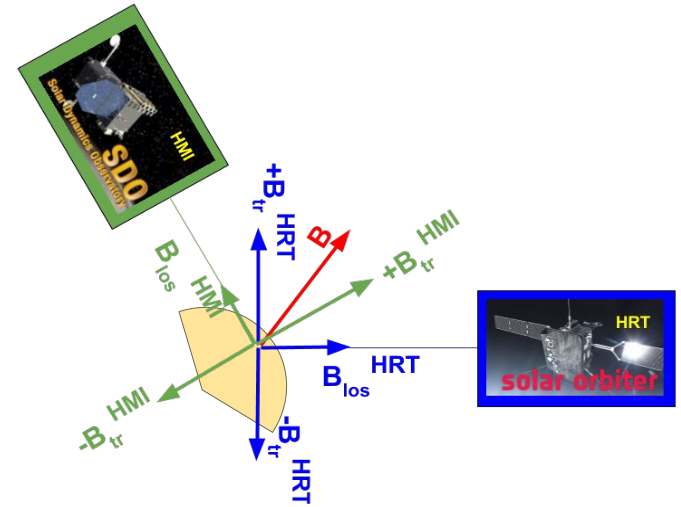
Figure 1. Stereoscopic disambiguation concept: The magnetic field, B, is observed by two telescopes, namely SO/PHI-HRT and SDO/HMI, separated by some finite angle. Then, the (unambiguous) BLoSHMI reveals the correct orientation of the ambiguous BtrHRT (see [1] for details).
A new opportunity: the Solar Orbiter Mission and the SO/PHI Instrument
The SO/PHI instrument typically provides maps of the continuum intensity, the magnetic field vector (BLoS, γ, φ), and the LoS-velocity with a cadence that is variable. SO/PHI is composed of 2 separate telescopes, namely: The Full-Disc Telescope (FDT) that images the entire solar disk and the High-Resolution Telescope (HRT) that observes a smaller part of the solar disk at higher resolution. The full Stokes vector is recorded at each pixel across the 2kx2k detector that the instrument employs. This full Stokes vector is recorded using a tunable filter system that scans the photospheric Fe I 617.3nm absorption line and the nearby continuum at 6 wavelengths [2].
The full spectropolarimetric capabilities of SO/PHI and the unique orbit of SO, combined with observations from Earth-bound observatories, allow for remote-sensing observations from different vantage points of the same area on the Sun, thereby providing the required observational constraints to remove the ambiguity in the transverse field (Figure 1).
Stereoscopic disambiguation method (SDM), in details
Radiative-transfer inversions of spectro-polarimetric observations provide estimates of the magnetic field B⃗ as, e.g.,
B⃗=B⃗LoS + σBtt⃗.
From this equation, one can infer the amplitude and orientation of the LoS component of the magnetic field (B⃗LoS) as well as the amplitude and direction t⃗ of the transverse component of the magnetic field (Bt> 0). The orientation σ = ±1 of the transverse component along t⃗ cannot, however, be determined.
The ambiguity in the orientation of the transverse component Br is a parity problem [3] in each pixel of the detector image plane. Hence, the disambiguation of a vector magnetogram is equivalent to fixing σ in each pixel of the image plane.
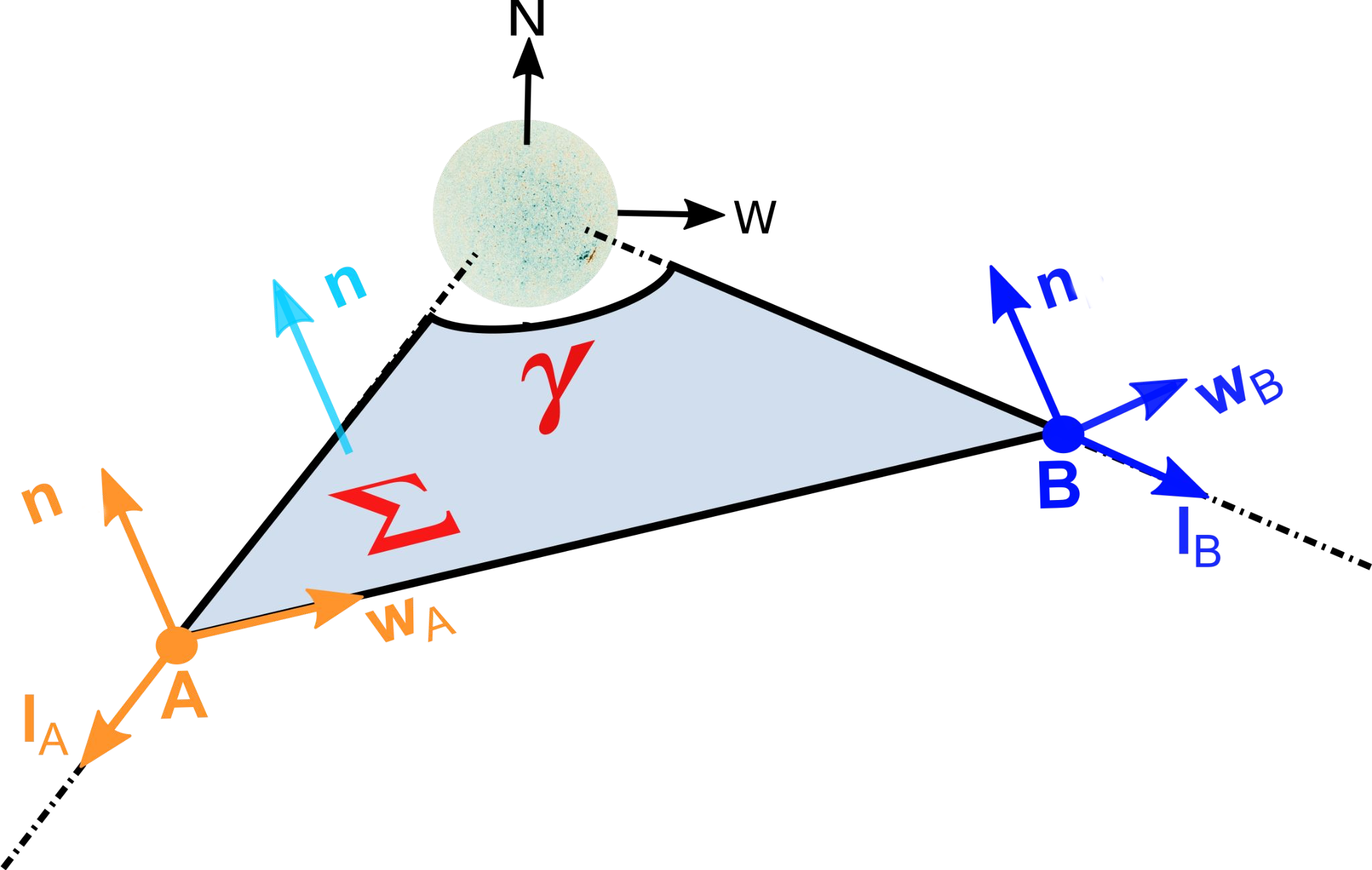
Figure 2. The SDM reference system. Here, A=SDO/HMI and B=SO/PHI-HRT.
SDM employs a special reference system (Figure 2) to remap SO/PHI-HRT and SDO/HMI observations such that:
- σ is computed as a combination of observed field components and the separation angle, ɣ, between the telescopes as: σ=(BLoSB - BLoSA cosɣ) / (BwA sinɣ);
- σ is geometrically equal to either +1 or -1 (nominal values);
- The components n∙B on the two telescopes are nominally identical by construction.
The SDM was developed and successfully tested on numerical simulations in [1]. The SDM is basically a pixel-by-pixel combination of observations from two telescopes onto the detector plane of one of the two. Therefore, an accurate remapping of the (ambiguous) vector field of, say, telescope A onto the detector plane of telescope B is required (see Figure 2). After such a remapping, the above equation provides σ as a simple analytical combination of measured quantities.
SDM application results
As an application example of SDM, we consider observations of AR12965, obtained by SO/PHI-HRT and SDO/HMI on 17/03/2022, when the separation angle between the two spacecraft was γ=27°. While the method can resolve simultaneously the ambiguity on both detectors, here we only show the ambiguity removal in B⃗t as observed by SO/PHI-HRT. The input to the method are the ambiguous SO/PHI and SDO/HMI vector magnetograms of AR12965. Figure 3 shows the successful application of the SDM to the disambiguation of observed data: the vector magnetic field on SO/PHI-HRT is fully determined, for the first time by using observations only. The transverse component is smooth, and pointing radially outwards from a positive flux concentration, as expected.
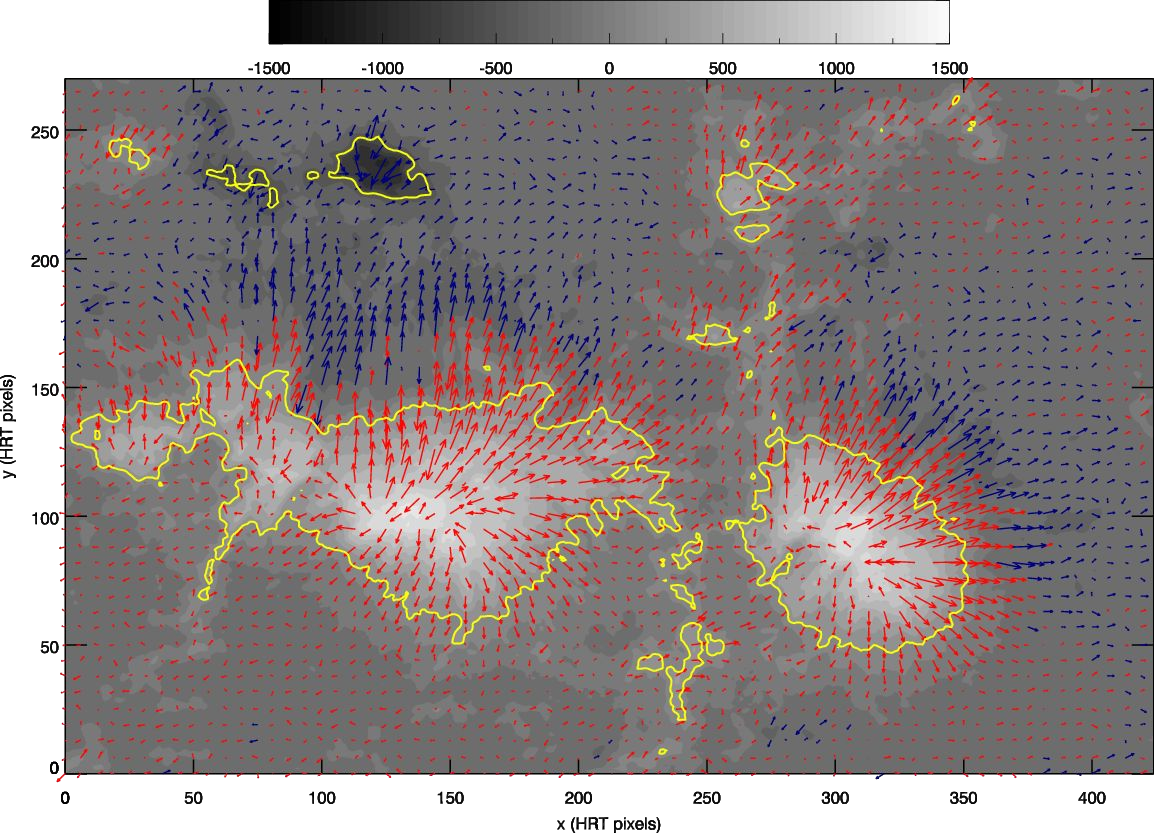
Figure 3. First stereoscopic-disambiguated HRT vector magnetogram. BLoS is plotted in grayscale. The red and blue arrows show the direction of the transverse component of the magnetic field on the positive and negative components of BLoS, respectively. The yellow isoline contours |BLoS|=400 G.
On the other hand, a few, unexpected orientations in localized, small regions are present (e.g. the left-pointing arrows around [330,80] in Figure 3). Such locations are positively identified by diagnostic metrics that SDM provides. In particular, the SDM is such that, nominally, σ = ±1, and that n∙B⃗ is the same for both telescopes. Such quantities can be used as a diagnostic of SDM results, meaning that departures from nominal values identify pixels where the SDM should not be applied because of differences in calibration and inversion between the employed data sets, optical distortion, or co-registration errors (Figure 4). Indeed, the unexpected orientations in Figure 3 correspond to locations where departures from nominal values in Figure 4 are present.
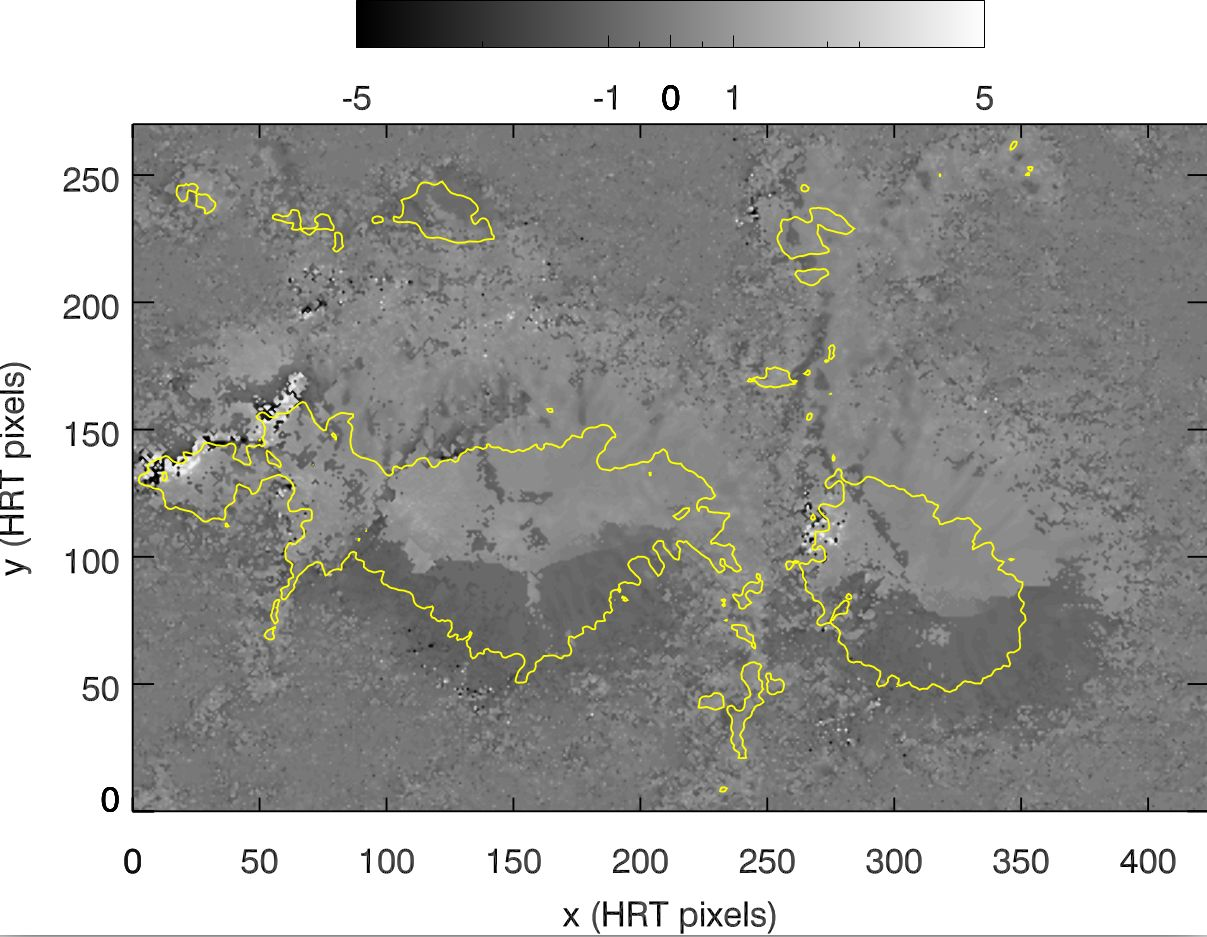
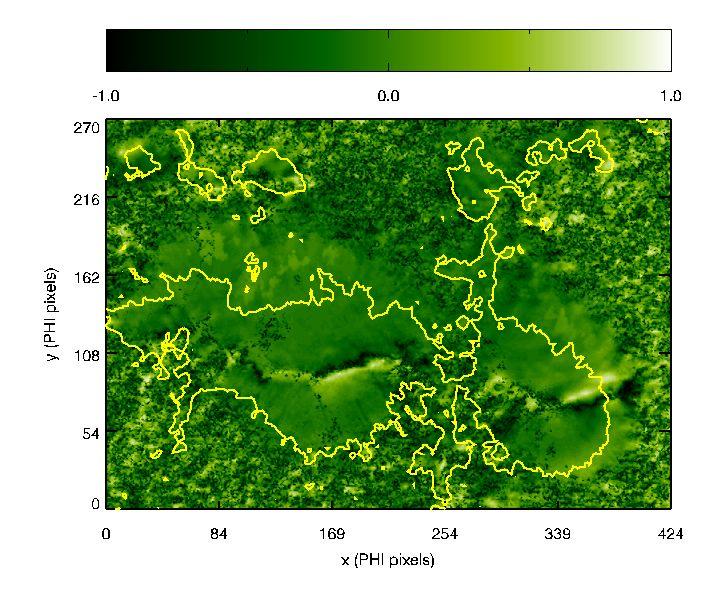
Figure 4. Computed σ (left) and normalized difference in n∙B⃗ (right) showing departures from nominal values.
Future applications
This first application proves that the SDM can accurately resolve the ambiguity in the transverse component of the magnetic field. Future applications will include:
- Combining SO/PHI-HRT with SDO/HMI at different distances and separation angles;
- Including other ground- and space-borne-telescopes, to study the dependence of SDM accuracy from the details of the observed spectral line;
- Benchmarking of traditional, single-view-point disambiguation methods;
- Incorporating data from the Vigil mission at L5 (at constant 1AU, γ=60° separation), whose Photospheric Magnetic field Imager (PMI) will provide vector magnetograms at 2.4" resolution and 30 minute cadence.
This study has been published in Gherardo Valori, et al., 2023, A&A, 677, A25, https://doi.org/10.1051/0004-6361/202345859
Further information on SO/PHI data is given at: https://www.mps.mpg.de/solar-physics/solar-orbiter-phi
Acknowledgements
Solar Orbiter is a space mission of international collaboration between ESA and NASA, operated by ESA. We are grateful to the ESA SOC and MOC teams for their support. The German contribution to SO/PHI is funded by the BMWi through DLR and by MPG central funds. The Spanish contribution is funded by AEI/MCIN/10.13039/501100011033/ and European Union “NextGenerationEU/PRTR” (RTI2018-096886-C5, PID2021-125325OB-C5, PCI2022-135009-2,PCI2022-135029-2) and ERDF “A way of making Europe”; ”Center of Excellence Severo Ochoa" awards to IAA-CSIC (SEV-2017-0709, CEX2021-001131-S); and a Ramón y Cajal fellowship awarded to DOS. The French contribution is funded by CNES. The HMI data are courtesy of NASA/SDO and the HMI science team.
Affiliations
1 Max-Planck-Institut für Sonnensystemforschung, Justus-von-Liebig-Weg 3, 37077 Göttingen, Germany e-mail: valori@mps.mpg.de
2 Instituto de Astrofísica de Andalucía (IAA-CSIC), Apartado de Correos 3004, E-18080 Granada, Spain
3 Sorbonne Université, École polytechnique, Institut Polytechnique de Paris, Université Paris Saclay, Observatoire de Paris-PSL, CNRS, Laboratoire de Physique des Plasmas (LPP), 75005 Paris, France
References
[1] Valori, Loeschl, Stansby, Pariat, Hirzberger, Chen. 2022, Sol.Phys., 297, 1, https://doi.org/10.1007/s11207-021-01942-x
[2] Solanki, S. K., del Toro Iniesta, J. C., Woch, J., et al. 2020, A&A, 642, A11, https://doi.org/10.1051/0004-6361/201935325
[3] Semel, Skumanich, 1998, A&A, 331
- Removed a total of (5) style margin:0;
Nuggets archive
2025
09/04/2025: Bursty acceleration and 3D trajectories of electrons in a solar flare
02/04/2025: Picoflare jets in the coronal holes and their link to the solar wind
19/03/2025: Radial dependence of solar energetic particle peak fluxes and fluences
12/03/2025: Analysis of solar eruptions deflecting in the low corona
05/03/2025: Propagation of particles inside a magnetic cloud: Solar Orbiter insights
19/02/2025: Rotation motions and signatures of the Alfvén waves in a fan-spine topology
12/02/2025: 'Sun'day everyday: 2 years of Solar Orbiter science nuggets that shed light on some of our star's mysteries
22/01/2025: Velocity field in the solar granulation from two-vantage points
15/01/2025: First joint X-ray solar microflare observations with NuSTAR and Solar Orbiter/STIX
2024
18/12/2024: Shocks in tandem : Solar Orbiter observes a fully formed forward-reverse shock pair in the inner heliosphere
11/12/2024: High-energy insights from an escaping coronal mass ejection
04/12/2024: Investigation of Venus plasma tail using the Solar Orbiter, Parker Solar Probe and Bepi Colombo flybys
27/11/2024: Testing the Flux Expansion Factor – Solar Wind Speed Relation with Solar Orbiter data
20/11/2024:The role of small scale EUV brightenings in the quiet Sun coronal heating
13/11/2024: Improved Insights from the Suprathermal Ion Spectrograph on Solar Orbiter
30/10/2024: Temporally resolved Type III solar radio bursts in the frequency range 3-13 MHz
23/10/2024: Resolving proton and alpha beams for improved understanding of plasma kinetics: SWA-PAS observations
25/09/2024: All microflares that accelerate electrons to high-energies are rooted in sunspots
25/09/2024: Connecting Solar Orbiter and L1 measurements of mesoscale solar wind structures to their coronal source using the Adapt-WSA model
18/09/2024: Modelling the global structure of a coronal mass ejection observed by Solar Orbiter and Parker Solar Probe
28/08/2024: Coordinated observations with the Swedish 1m Solar Telescope and Solar Orbiter
21/08/2024: Multi-source connectivity drives heliospheric solar wind variability
14/08/2024: Composition Mosaics from March 2022
19/06/2024: Coordinated Coronal and Heliospheric Observations During the 2024 Total Solar Eclipse
22/05/2024: Real time space weather prediction with Solar Orbiter
15/05/2024: Hard X ray and microwave pulsations: a signature of the flare energy release process
01/02/2024: Relativistic electrons accelerated by an interplanetary shock wave
11/01/2024: Modelling Two Consecutive Energetic Storm Particle Events observed by Solar Orbiter
2023
14/12/2023: Understanding STIX hard X-ray source motions using field extrapolations
16/11/2023: EUI data reveal a "steady" mode of coronal heating
09/11/2023: A new solution to the ambiguity problem
02/11/2023: Solar Orbiter and Parker Solar Probe jointly take a step forward in understanding coronal heating
25/10/2023: Observations of mini coronal dimmings caused by small-scale eruptions in the quiet Sun
18/10/2023: Fleeting small-scale surface magnetic fields build the quiet-Sun corona
27/09/2023: Solar Orbiter reveals non-field-aligned solar wind proton beams and its role in wave growth activities
20/09/2023: Polarisation of decayless kink oscillations of solar coronal loops
23/08/2023: A sharp EUI and SPICE look into the EUV variability and fine-scale structure associated with coronal rain
02/08/2023: Solar Flare Hard Xrays from the anchor points of an eruptive filament
28/06/2023: 3He-rich solar energetic particle events observed close to the Sun on Solar Orbiter
14/06/2023: Observational Evidence of S-web Source of Slow Solar Wind
31/05/2023: An interesting interplanetary shock
24/05/2023: High-resolution imaging of coronal mass ejections from SoloHI
17/05/2023: Direct assessment of far-side helioseismology using SO/PHI magnetograms
10/05/2023: Measuring the nascent solar wind outflow velocities via the doppler dimming technique
26/04/2023: Imaging and spectroscopic observations of EUV brightenings using SPICE and EUI on board Solar Orbiter
19/04/2023: Hot X-ray onset observations in solar flares with Solar Orbiter/STIX
12/04/2023: Multi-scale structure and composition of ICME prominence material from the Solar Wind Analyser suite
22/03/2023: Langmuir waves associated with magnetic holes in the solar wind
15/03/2023: Radial dependence of the peak intensity of solar energetic electron events in the inner heliosphere
08/03/2023: New insights about EUV brightenings in the quiet sun corona from the Extreme Ultraviolet Imager








































 Sign in
Sign in
 Science & Technology
Science & Technology